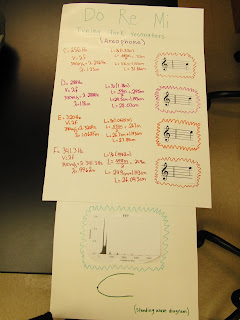The task here was to create a musical instrument which is in tune with the rest of the musical world (providing evidence of that), can play a short but recognizable tune, and describing the timbre and standing wave properties by graphs and diagrams. At the end, the groups present their instruments and their mini-posters.
During the course of the project, each instrument is revised a lot; some completely change and some need model tweaks - using the end correction, sometimes the tension/wavespeed relationship or Helmholtz resonators (none of which they knew about before this). It's a great chance to really experience that prototype/revision cycle.
Here are some of the projects, and links to the recordings:
- Capped tube marimba - this is an instrument made of PVC tubes, played with a mallet on the caps. Video
- PVC pan flute: this is really more of a PVC bugle assembly, made from five pipes played by one player. This had a really interesting behavior in that it behaved both like it had open ends and one closed end. Video
- PVC trumpets - similar to the one above, but played with teamwork. Some evidence of that dual behavior is seen here as well. Video
- Uketair - it's always difficult to build a string instrument. This group did a good job of building a resonating box, using shaved golf tees for stable tuning pegs, and making a bridge from a bolt. The fishing line strings stretch too much after tensioning, which makes it really difficult to keep in tune, but the principle's there. Video
- Tuning fork resonators: these were custom-cut tubes that amplified the sounds of tuning forks. Even at that, they weren't super-loud, so they recorded the sounds and arranged the song in Garage Band. Video
- Leg Marimba - this one was going to be a Blue Man Group PVC and paddle instrument, but the paddles didn't work too well, so they revised to using their hands and then (in a stroke of genius) to their legs. Video
- PVC Clarinet - This one wasn't really a clarinet, since it used buzzing, but the first design involved a reed. I had a couple of groups use reeds successfully last year, but none stuck with it this year. This was the first instrument that I've had with a reasonable implementation of holes to change the pitch. The timbre gets crazy after several are uncovered, but it does a reasonably good job of producing an intelligible pitch.
- Batterie De L'eau (water drums) - this one also went through several revisions. By the end, they used a small strip of paper across a plastic container filled partially with water. By using the end correction, the contained resonated to selectively amplify the desired frequencies from the noise of the paper strip. It's a noisy sound, but the pitch is clearly audible. Video
- Pan Flute - this one's a PVC pan flute proper. The end correction proved a little trickier in here (I think that the face near the end affects the dynamics a bit, reducing that effective length), but worked out well overall. Video












No comments:
Post a Comment